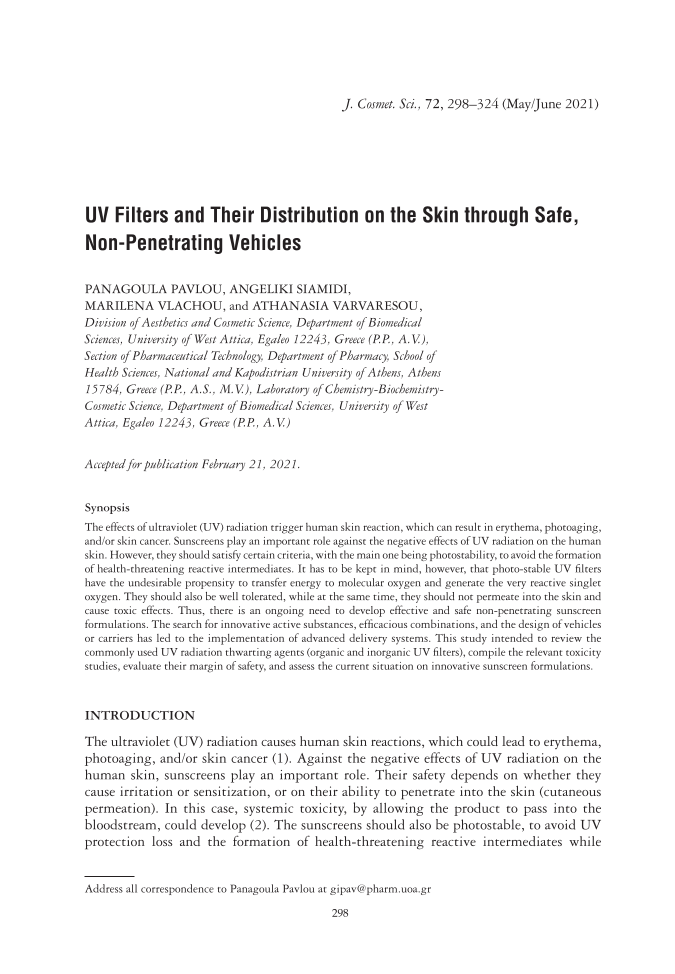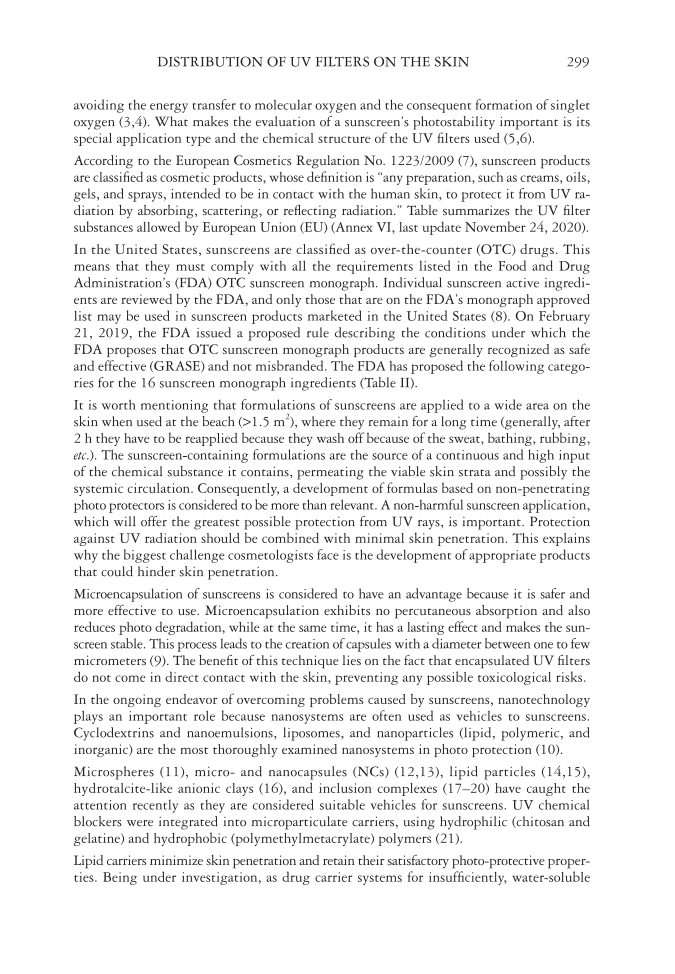UV Filters and Their Distribution on the Skin through Safe, Non-Penetrating Vehicles PANAGOULA PAVLOU, ANGELIKI SIAMIDI, MARILENA VLACHOU, and ATHANASIA VARVARESOU , Division of Aesthetics and Cosmetic Science, Department of Biomedical Sciences, University of West Attica, Egaleo 12243, Greece (P.P., A.V.), Section of Pharmaceutical Technology, Department of Pharmacy, School of Health Sciences, National and Kapodistrian University of Athens, Athens 15784, Greece (P.P., A.S., M.V.), Laboratory of Chemistry-Biochemistry- Cosmetic Science, Department of Biomedical Sciences, University of West Attica, Egaleo 12243, Greece (P.P., A.V.) Accepted for publication February 21, 2021. Synopsis The effects of ultraviolet (UV) radiation trigger human skin reaction, which can result in erythema, photoaging, and/or skin cancer. Sunscreens play an important role against the negative effects of UV radiation on the human skin. However, they should satisfy certain criteria, with the main one being photostability, to avoid the formation of health-threatening reactive intermediates. It has to be kept in mind, however, that photo-stable UV fi lters have the undesirable propensity to transfer energy to molecular oxygen and generate the very reactive singlet oxygen. They should also be well tolerated, while at the same time, they should not permeate into the skin and cause toxic effects. Thus, there is an ongoing need to develop effective and safe non-penetrating sunscreen formulations. The search for innovative active substances, effi cacious combinations, and the design of vehicles or carriers has led to the implementation of advanced delivery systems. This study intended to review the commonly used UV radiation thwarting agents (organic and inorganic UV fi lters), compile the relevant toxicity studies, evaluate their margin of safety, and assess the current situation on innovative sunscreen formulations. INTRODUCTION The ultraviolet (UV) radiation causes human skin reactions, which could lead to erythema, photoaging, and/or skin cancer (1). Against the negative effects of UV radiation on the human skin, sunscreens play an important role. Their safety depends on whether they cause irritation or sensitization, or on their ability to penetrate into the skin (cutaneous permeation). In this case, systemic toxicity, by allowing the product to pass into the bloodstream, could develop (2). The sunscreens should also be photostable, to avoid UV protection loss and the formation of health-threatening reactive intermediates while Address all correspondence to Panagoula Pavlou at gipav@pharm.uoa.gr J. Cosmet. Sci., 72, 298–324 (May/June 2021) 298
avoiding the energy transfer to molecular oxygen and the consequent formation of singlet oxygen (3,4). What makes the evaluation of a sunscreen’s photostability important is its special application type and the chemical structure of the UV fi lters used (5,6). According to the European Cosmetics Regulation No. 1223/2009 (7), sunscreen products are classifi ed as cosmetic products, whose defi nition is “any preparation, such as creams, oils, gels, and sprays, intended to be in contact with the human skin, to protect it from UV ra- diation by absorbing, scattering, or refl ecting radiation.” Table summarizes the UV fi lter substances allowed by European Union (EU) (Annex VI, last update November 24, 2020). In the United States, sunscreens are classifi ed as over-the-counter (OTC) drugs. This means that they must comply with all the requirements listed in the Food and Drug Administration’s (FDA) OTC sunscreen monograph. Individual sunscreen active ingredi- ents are reviewed by the FDA, and only those that are on the FDA’s monograph approved list may be used in sunscreen products marketed in the United States (8). On February 21, 2019, the FDA issued a proposed rule describing the conditions under which the FDA proposes that OTC sunscreen monograph products are generally recognized as safe and effective (GRASE) and not misbranded. The FDA has proposed the following catego- ries for the 16 sunscreen monograph ingredients (Table II). It is worth mentioning that formulations of sunscreens are applied to a wide area on the skin when used at the beach ( 1.5 m2), where they remain for a long time (generally, after 2 h they have to be reapplied because they wash off because of the sweat, bathing, rubbing, etc.). The sunscreen-containing formulations are the source of a continuous and high input of the chemical substance it contains, permeating the viable skin strata and possibly the systemic circulation. Consequently, a development of formulas based on non-penetrating photo protectors is considered to be more than relevant. A non-harmful sunscreen application, which will offer the greatest possible protection from UV rays, is important. Protection against UV radiation should be combined with minimal skin penetration. This explains why the biggest challenge cosmetologists face is the development of appropriate products that could hinder skin penetration. Mi croencapsulation of sunscreens is considered to have an advantage because it is safer and more effective to use. Microencapsulation exhibits no percutaneous absorption and also reduces photo degradation, while at the same time, it has a lasting effect and makes the sun- screen stable. This process leads to the creation of capsules with a diameter between one to few micrometers (9). The benefi t of this technique lies on the fact that encapsulated UV fi lters do not come in direct contact with the skin, preventing any possible toxicological risks. In the ongoing endeavor of overcoming problems caused by sunscreens, nanotechnology plays an important role because nanosystems are often used as vehicles to sunscreens. Cyclodextrins and nanoemulsions, liposomes, and nanoparticles (lipid, polymeric, and inorganic) are the most thoroughly examined nanosystems in photo protection (10). Mi crospheres (11), micro- and nanocapsules (NCs) (12,13), lipid particles (14,15), hydrotalcite-like anionic clays (16), and inclusion complexes (17–20) have caught the attention recently as they are considered suitable vehicles for sunscreens. UV chemical blockers were integrated into microparticulate carriers, using hydrophilic (chitosan and gelatine) and hydrophobic (polymethylmetacrylate) polymers (21). Lipid carriers minimize skin penetration and retain their satisfactory photo-protective proper- ties. Being under investigation, as drug carrier systems for insuffi ciently, water-soluble DISTRIBUTION OF UV FILTERS ON THE SKIN 299
Purchased for the exclusive use of nofirst nolast (unknown) From: SCC Media Library & Resource Center (library.scconline.org)


















































































































